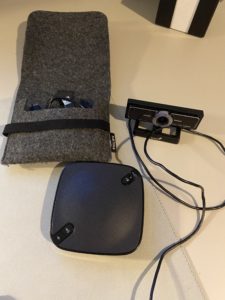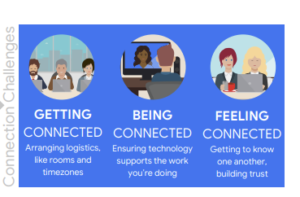That’s a question many teams have struggled with since Covid19 changed our way of working since March. But to what extend did Covid19 change our way of working? In this post I like share my thoughts and give some tips and tricks.
Distributed teams before Covid19
I have been working with distributed teams since 2010. Our standard routine was to first launch a team together onsite and work together for 6 weeks. After this period the relationships and way of working would be established. Team collaboration would be good. Team members would return home. Once every quarter team members would be together on site to align for a PI planning (big room planning) and joint retrospective.
In January 2016 I delivered a training for 3 security operation teams in Boston. One of the teams was working together for 5 years. This training was the first time they actually met for the first-time face 2 face. I was just flabbergasted. How could this work? During the training I changed the schedule, so team members and teams had some more time to align.
In general, only teams with many team members on different locations or across different time zones would be a challenge. Next cultural differences could impact collaboration significantly.
Distributed teams since Covid19
To be honest not much changed in my work when Covid19 hit The Netherlands, US and India. I worked for a large multinational with team members in India, The Netherlands and United Kingdom. Primarily we worked together online. We bonded more together because we shared more on our personal life. The psychological safety in the teams increased. Sadly because of the economic impact of Covid19 my contract was terminated end of April.
Luckily, I started with a new assignment May 25th. I became Scrum Master of 5 SAP (activate) teams. Before Covid19 all teams were collocated using physical Scrum Boards with post-it’s. These teams were in for a steep learning curve. Learning how to collaborate with MS Teams, Jira, Miro was a challenge. Next the project timeline was very ambitious.
Learnings
Teams need good video conferencing, group chat and sharing tools.
MS Teams, Zoom or Google Meet are good tools. I prefer Zoom because the breakout zooms give more room for close conversations between team members in sprint retrospectives. In the near future MS Teams will also make available a breakout rooms.
Teams need one online place to track their tasks and progress
Teams need one place to check priority and dependencies between tasks. In both assignments Jira or MS Azure DevOps were used. Excel is not a feasible alternative.
Teams learn the hard way more written communication is required
Co-located teams are used to simply talk to each other to handover tasks for testing. Communication is direct and synchroom. Handing over by using comment fields in Jira/Azure DevOps can help teams.
More communication is required for teams
In general, there is a tendency to communicate lesser in distributed teams comparing with collocated teams. Distributed teams miss the passive communication of conversations of colleges. Any additional communication needs to be organized.
Start team meeting with open ended question.
Team need time to talk on personal things. This will help feel connected and improve the trust (Safety).
Covid19 specific learnings
Before Covid19 we would like to prevent teams would be working on more than 3 locations. From more location’s teams would be called fragmented teams. This is the most difficult type of distributed teams. Additional mitigations (tips) are required.
Invest in home workplace and tooling
In the beginning of Covid19 I worked behind the kitchen table. This was okay for a short time. As soon as we learned we would work from home for months I invested in a good workplace with the right tools for online meetings. I vacated a room and changed it into a working room. This would would prevent all kind of physical issues with my back and neck. Next the mental switch between work and personal life is easer. You simply close the door of the working room.
Set Team norms on communication
Make sure team members are on MS Teams during working hours. If collaboration is required use channels to talk or chat. Teams can have a tendency to use email for collaborations ending up in long email chains. Try to prevent this, email hockey, by using direct calls or phone calls.
Create focus by clear and short lists for teams to work on
Multitasking is a productivity killer. For teams working from home the risk of multitasking is bigger because working alone can be hard. Having clear goals and short list of tasks in Jira or Azure DevOps teams will prevent this.
Over-communicate project timelines and updates
Distributed teams have a higher risk of creating a “them against us” pattern because more people are in one location. With Covid19 I notice this pattern can be stronger because team members don’t see program management at the coffee machine and have a short chit chat. The only way to prevent this pattern from happing is to over-communicate.
Make team norms on working hours
In a retrospective on working from home for 8 weeks team members shared they make more hours than normally in office. It’s important have clear expectations of working hours and when team members are available.
Schedule time for fun events / online office drinks
Teams miss the informal coffee machine moments or office drinks. It’s important organise this online. It’s not like meeting in person but it’s better than nothing. Below you can see a brilliant example of a Google danse team:

1 on 1 check-ins
Schedule 1 on 1 calls to talk with team members to talk on their personal situation. Also check if team members don’t burn out. The risk of burning out during Covid19 is much higher than normal.
Be vulnerable in meetings
Be open on your own struggles working from home. Working from home can feel like the movie “Groundhog Day”. Every day feels the same. The routine helps to work but the routine can also be killing mentally. Team mates gave great suggestions to break the Groundhog Day syndrome.
After Covid19 tips
All-most every organization now has experience with the teams working from home. Team members shared they like working from home because they don’y need to commute and save time and have flexible working hours. They can be more focussed and be more productive. They learned meetings are more to the point and shorter but need more structure. Try to prevent back to back meetings and schedule some time in between. Team member miss going to office and meet colleges face to face.
In 2021 I expect teams will return partly to office and will work from office 1 to 2 days a week. Here are some tips for teams when they return to office:
Check office video conferencing equipment and network bandwidth
I notice not all offices are equipped with video conferencing facilities. I always bring my own speaker and webcam to be able to connect the office with team members at home. I my case we were with a limited number of people in Office. So the impact on the network bandwidth was limited. Be sure to check your network before start to return to office. The impact of Skype for Business and MS Teams is huge.

Create a schedule for teams
The demand for meeting room was high before Covid19 hit. The demand for dedicated meeting rooms with video conferencing room will be higher. Create a schedule to spread the demand during the week.
Conclusion
Google research shows that distributed work can be as effective as working in the same office. I expect more teams will work from home when we return to normal. But working from home isn’t always as easy or enjoyable. Why? Employees struggle to create 3 types of high-quality connections:
- Getting connected
- Being connected
- Feeling connected

Contact
Feel free to contact if you want more info on this topic. Just sent me an direct message or email (info@doelenconsultancy.nl)
Sources
Google created a great playbook on distributed work and has a series of post on this
